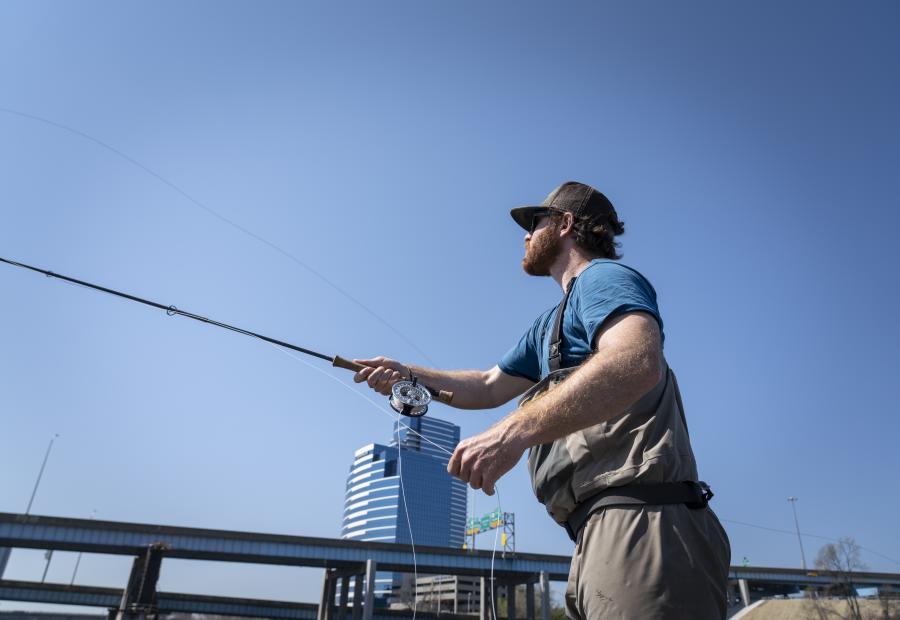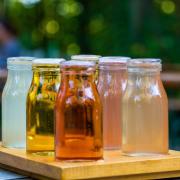As summer winds down and thoughts turn to fall, area sport anglers often turn their attention to the Grand River. September is prime time for salmon runs. The city’s downtown fishery draws anglers from all over Michigan who come looking for an exciting urban fishing experience.
What’s not to love about hooking a 6-pound coho salmon, often called silver salmon? They’re known for their aggressive nature and willingness to strike baits, and the orange-red meat beneath their silvery skin is excellent table fare. The much larger chinook salmon puts up an even bigger battle, and is guaranteed to provide a memorable angling moment.
State fisheries experts say the Grand River’s fall runs can bring thousands of coho salmon through the Grand Rapids’ riverfront on their journey upstream to spawn. Far fewer of the big chinooks are expected these days because fewer have been raised at state hatcheries and stocked in recent years. (If you have your heart set on chinook, you might head to nearby Lake Michigan – the Department of Natural Resources released one million of them into the lake in Spring 2023).
Timing is Everything
You’ll want to head to the Grand River when conditions are right.
“The biggest thing about timing is water temperature. If temperatures are in the 60s the fish will come upstream,” explains Jay Wesley, a fisheries biologist and the state’s Lake Michigan Basin coordinator with the Michigan Department of Natural Resources. “If it’s really warm, they will delay… based on historical data we get at Webber Dam (upstream from Grand Rapids), the first peak (of the coho run) typically is in mid to late September. We get a second peak during the first two weeks of November. They come and move through fairly quickly.
Anglers need to move fast when they do. A great way to check the status of the runs is the DNR’s weekly online weekly fishing report.
“The chinooks start running in late September and peak in October. Our chinook run on the Grand River is now much smaller than it was in the 1970s and 1980s, but the fall runs also include steelhead. Summer-run steelheads are in the river in September and a Michigan strain runs late in September, but the peak of the fall steelhead run is typically mid-November.”
The agency stocks the Grand River annually with young coho salmon. The Rogue River, a tributary of the Grand in Rockford, 20 minutes north of Grand Rapids, also receives an annual plant.

September through mid-November is the time for salmon runs.
Photo by Experience Grand Rapids
Prime Fishing Spots
“The best spot to fish salmon is at the Sixth St. Dam in downtown Grand Rapids,” Wesley said. “If people are new to the area and don’t want to battle the crowds at the dam, there is also good fishing downstream where there are places people can wade when the water is lower, or they can cast from shore.
“The second best spot is up on the Rogue River. It’s a smaller river system and is easier to wade and has a wilder character. It is also (relatively) close to downtown.”
Sixth St. Dam is the first major barrier for salmon making their long journey inland from Lake Michigan. That’s where they and anglers congregate. A fish ladder at Fish Ladder Park on the west bank allows them to find their way upstream to spawning locations.
Fish Ladder Park is also a great location to watch others fish or get a look at the salmon as they try to leap the dam or swim through the ladder following the current. Fishing is not allowed there but anglers use the walkway to access the river on the west bank.
A state fishing license is required to fish in Michigan if you are 17 years or older. An all-species fishing license is currently $26 for Michigan residents and $76 for non-residents. The license is valid from March 1 of a given year through March 31 of the following year. They are available at Meijer stores, local bait and tackle shops and online.
May the fish be with you this fall!
Recreational Activities
Explore area farms, hiking, hunting, fishing and other recreational activities.



